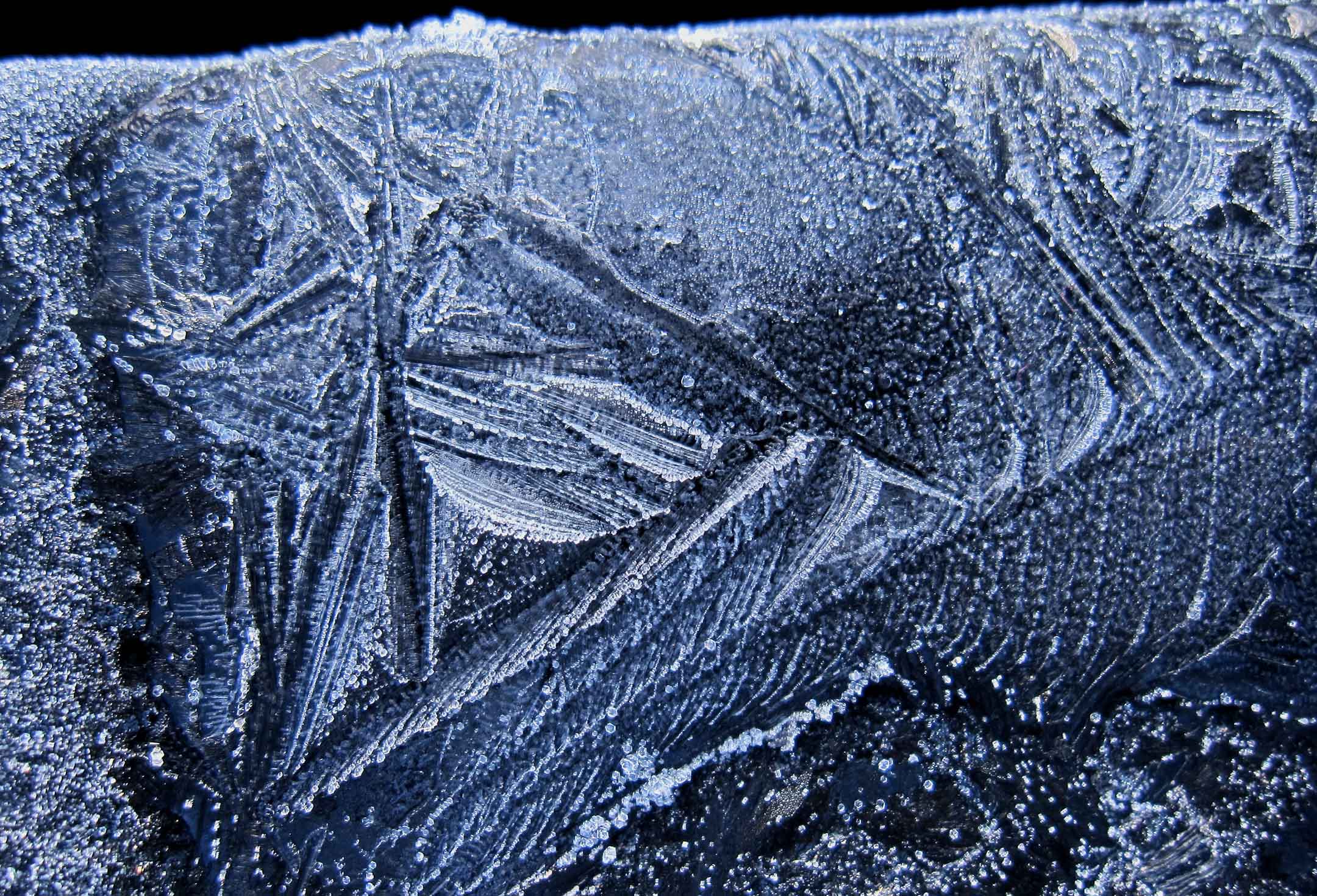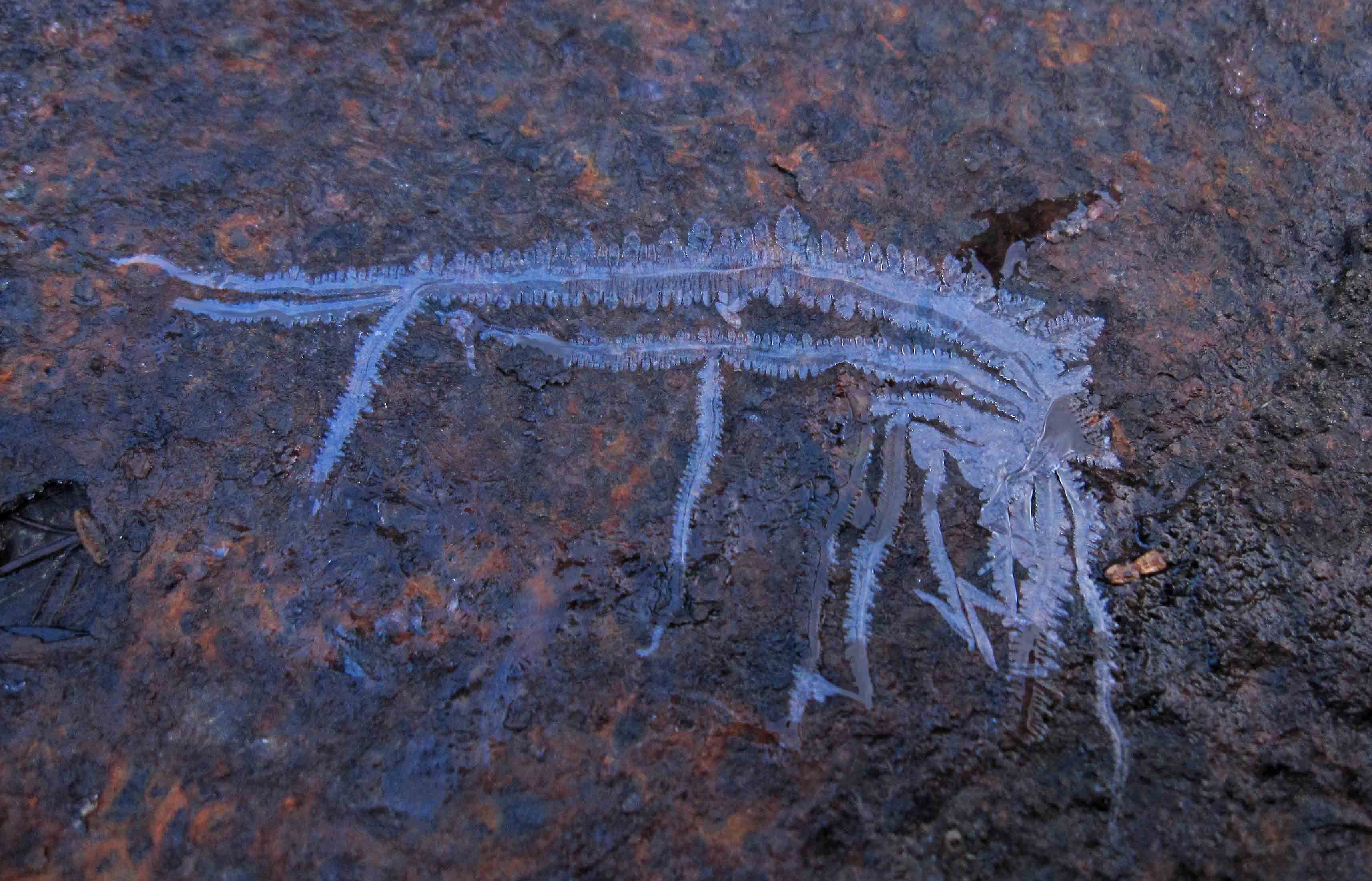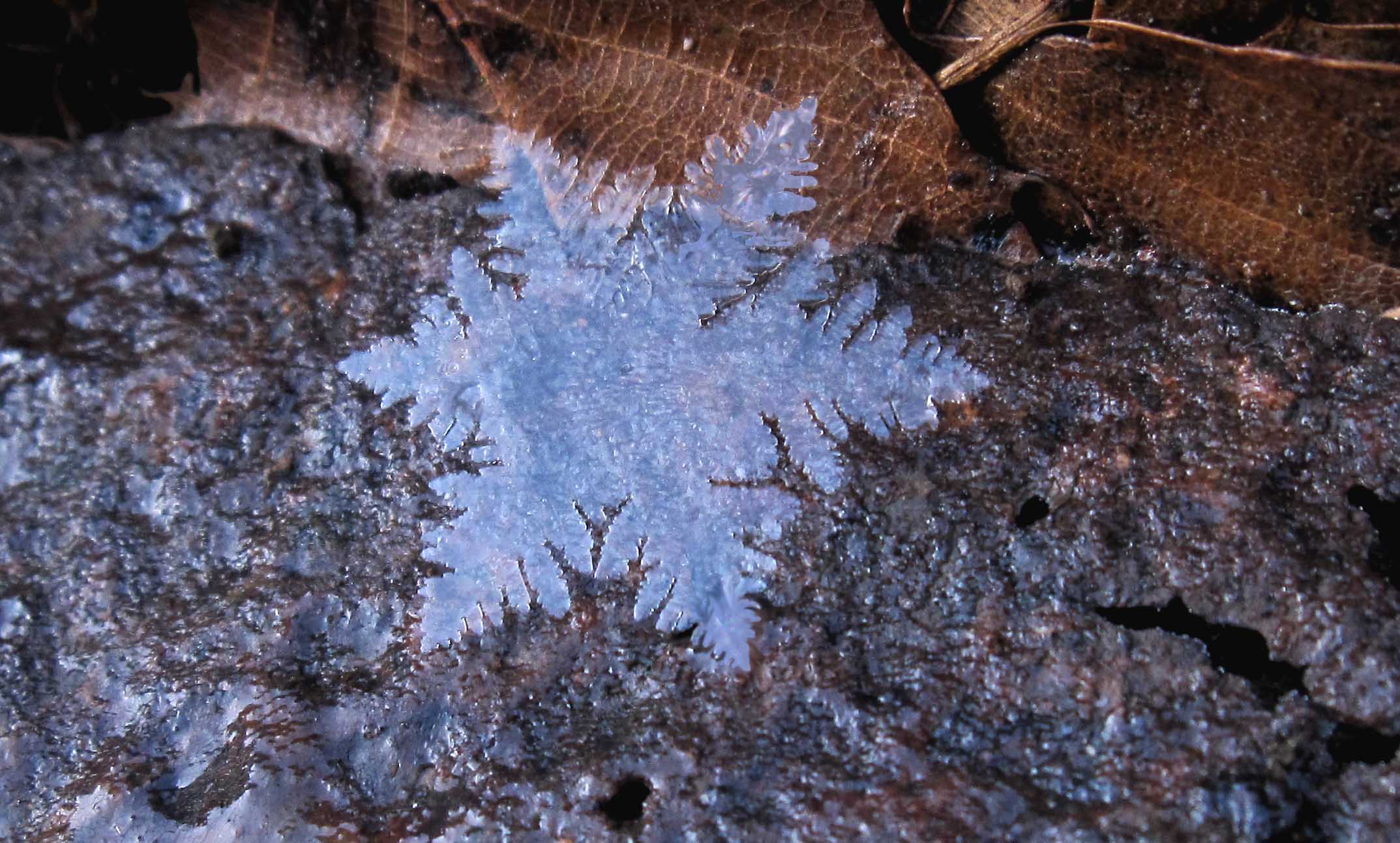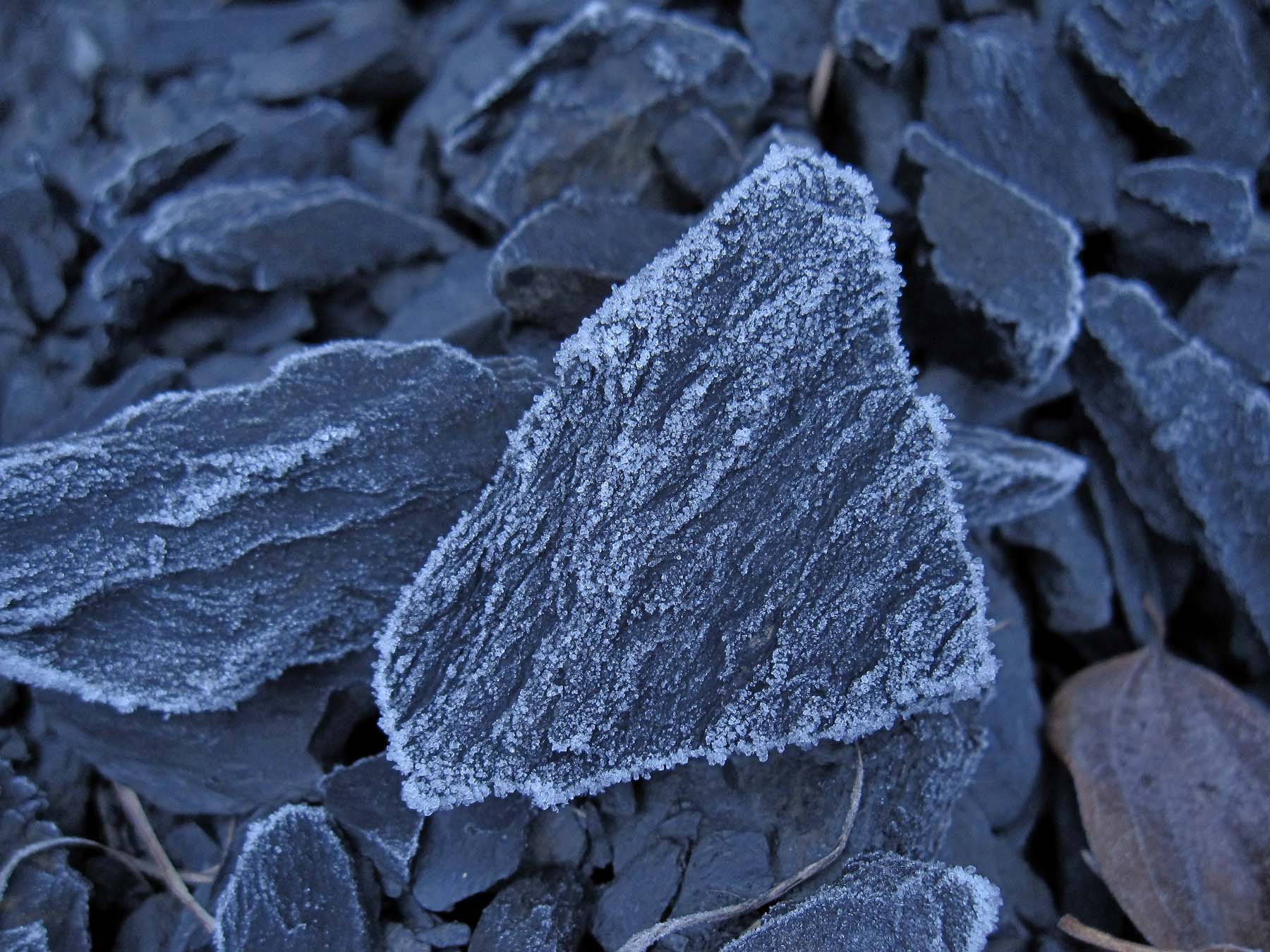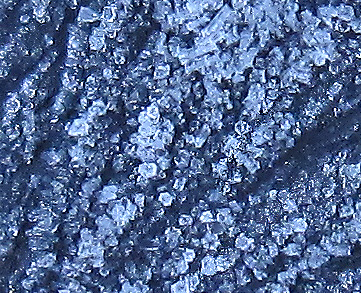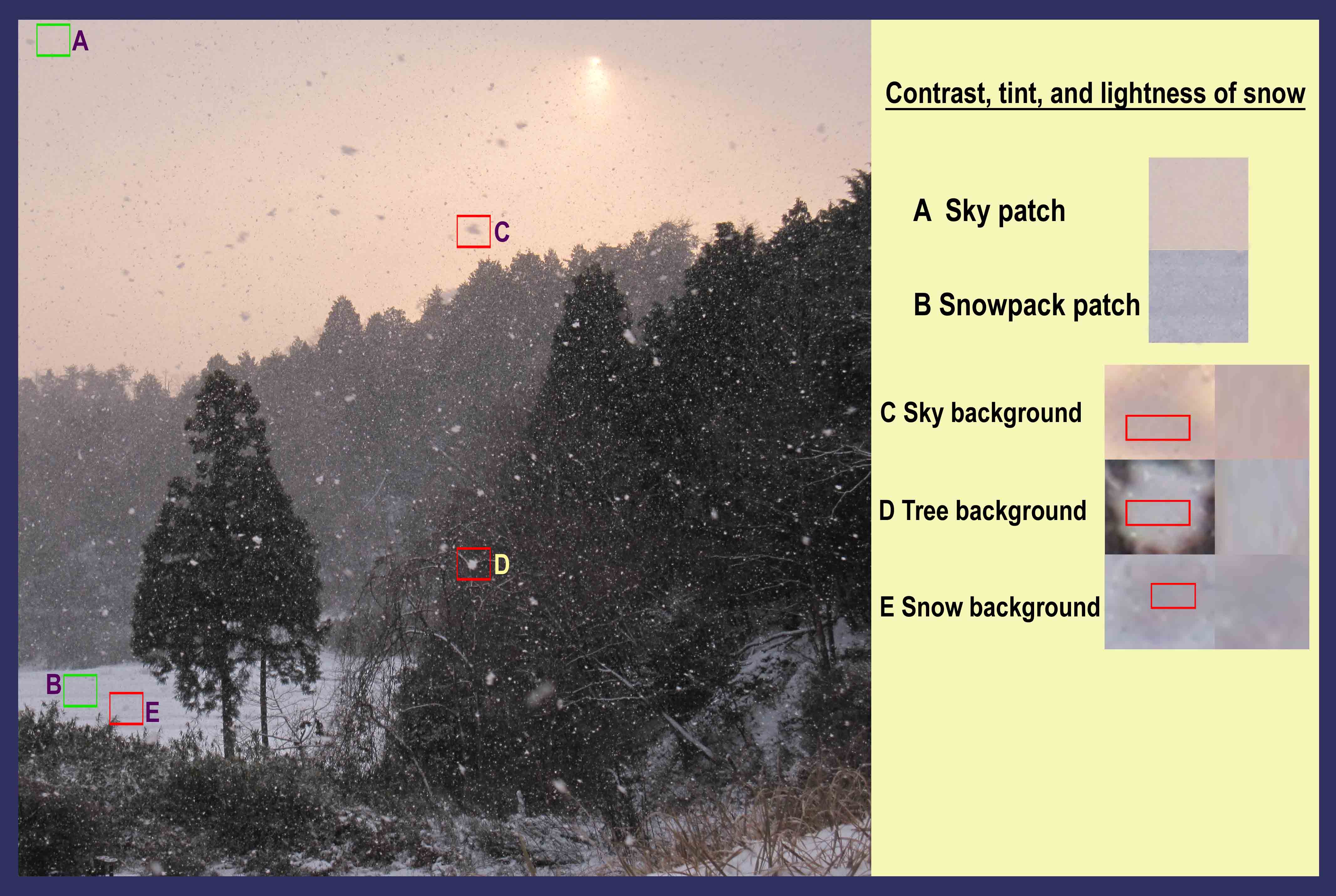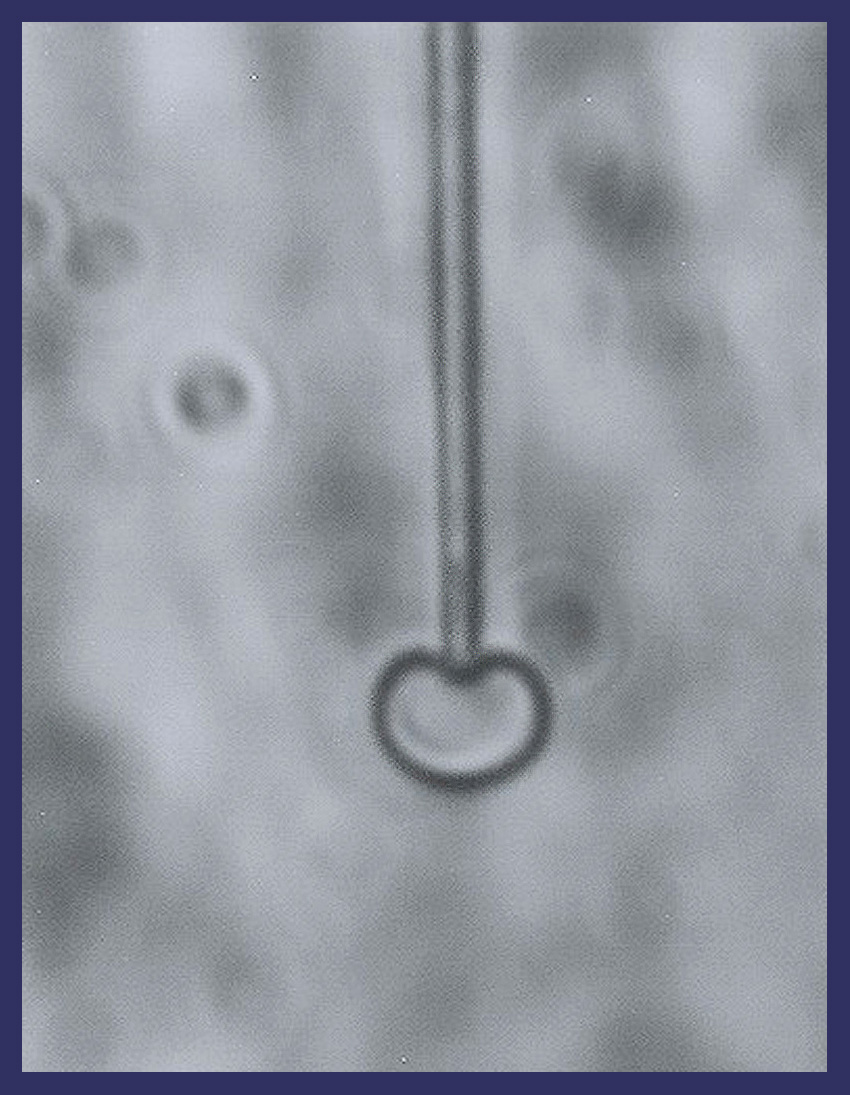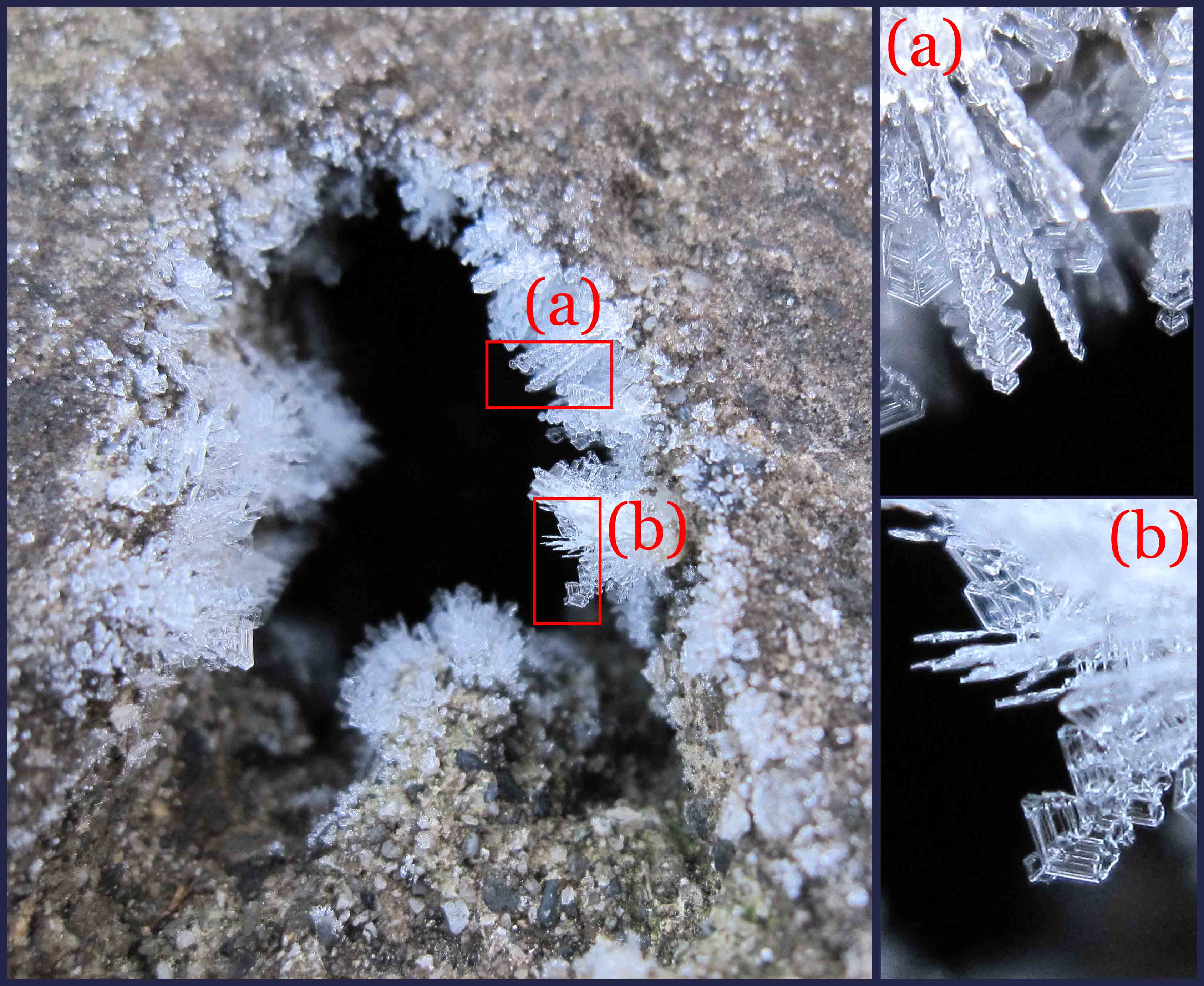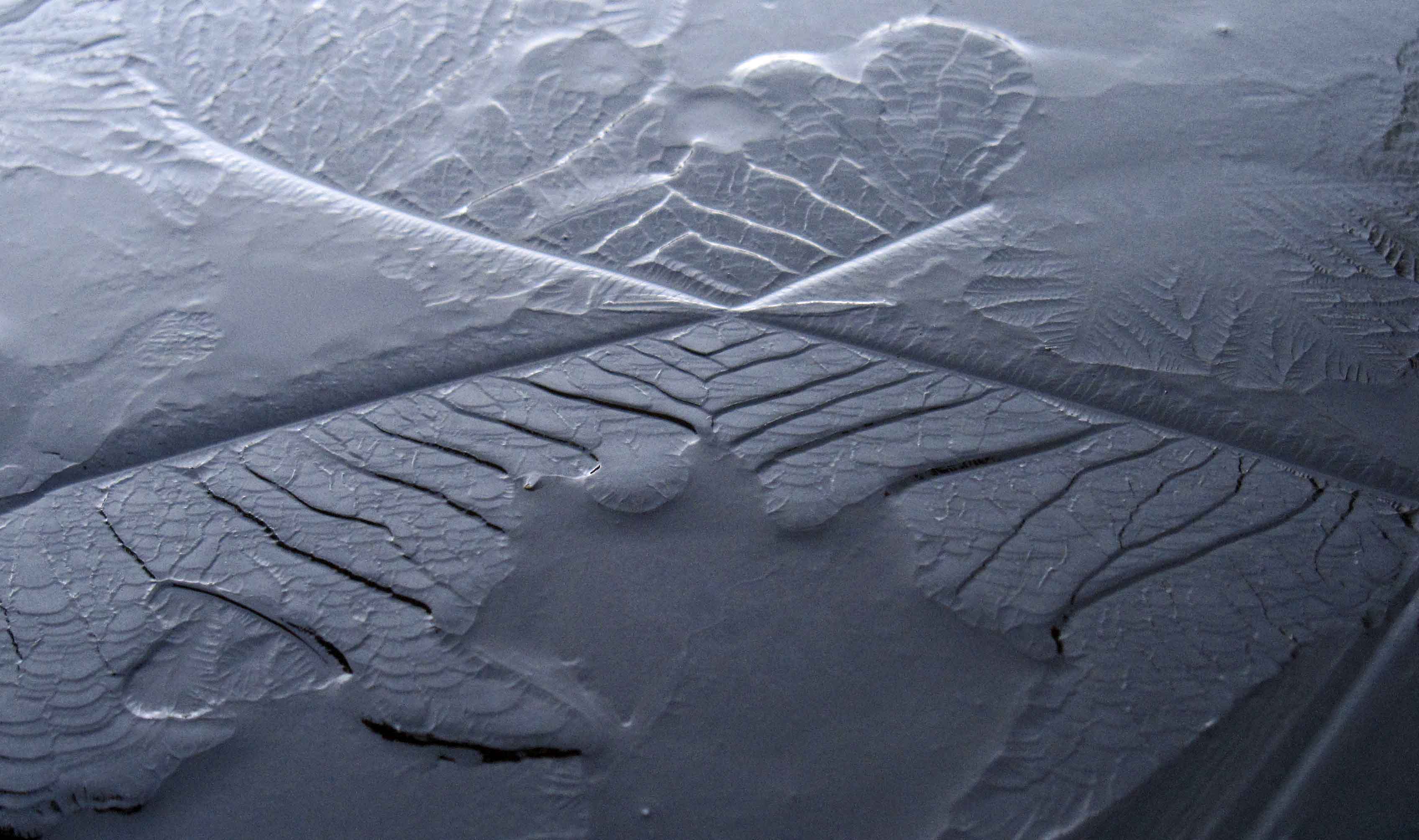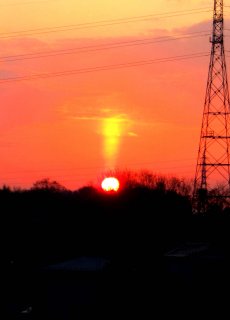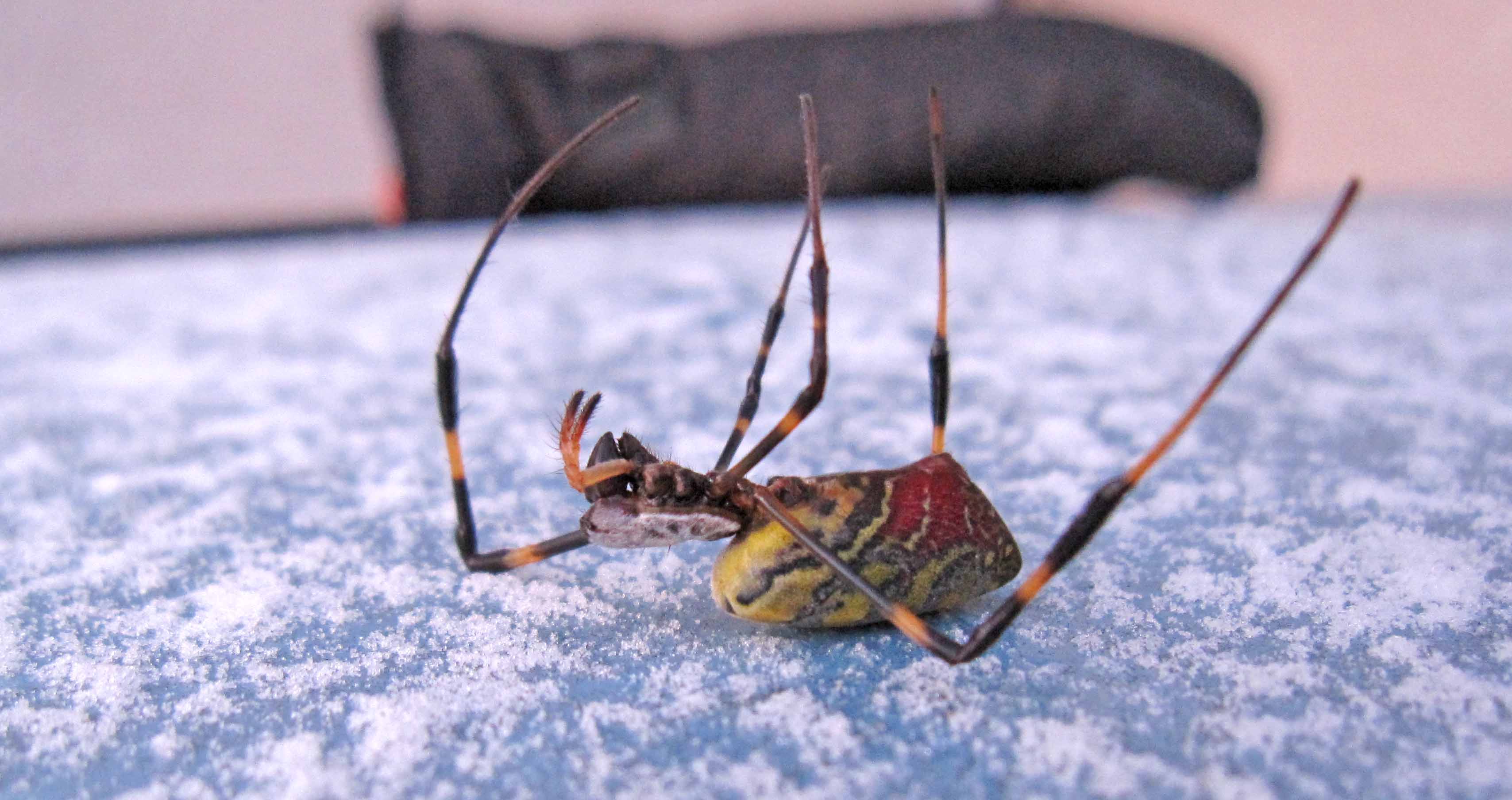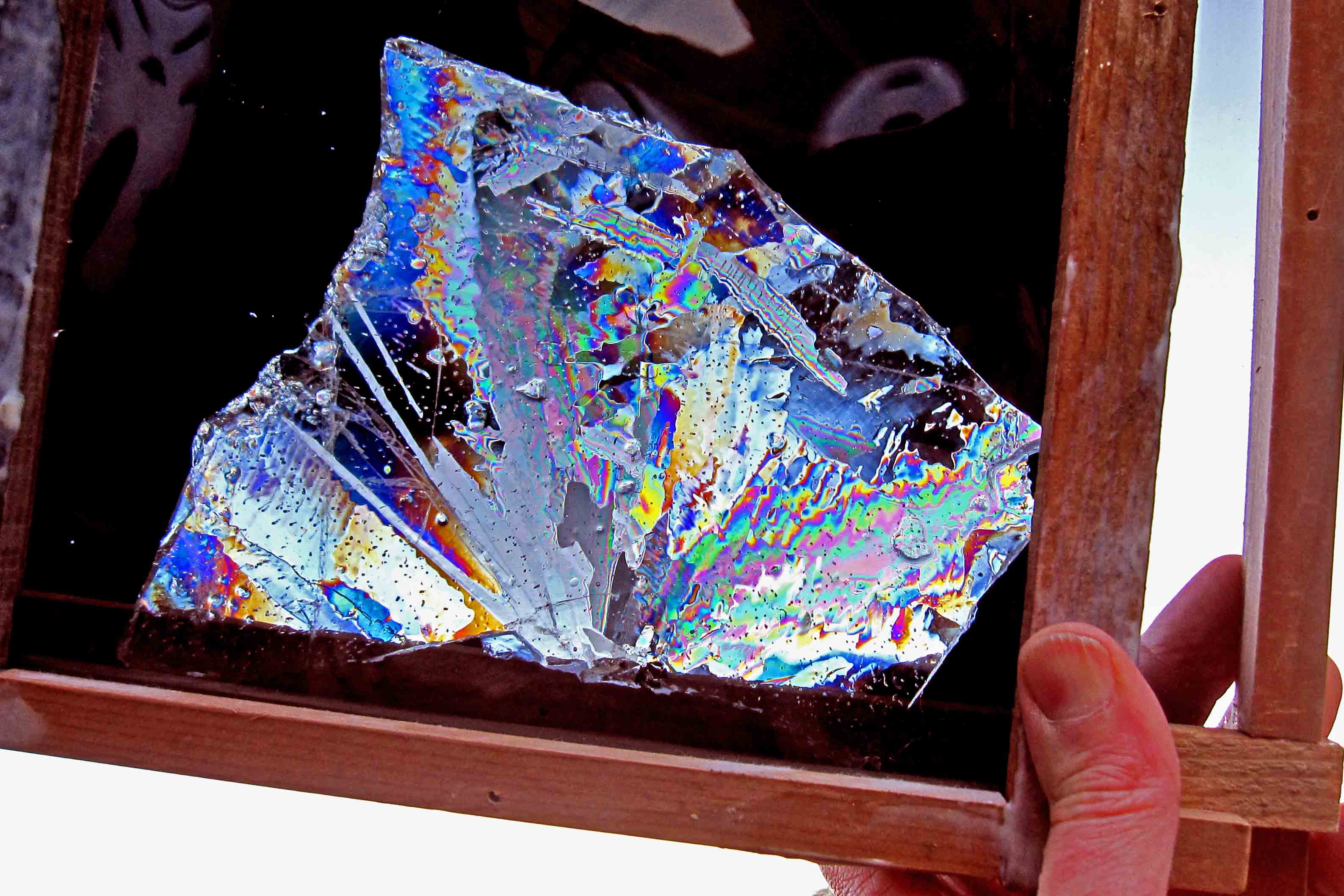Frost World
January 9th, 2010Whenever I am taking a picture on macro near the maximum close-up to an object, the aperture on my little Canon automatically sets to the maximum size, which means that the resulting images are in focus only at the center. Ever since I got the camera in late 2008, I've wondered how to get past this problem. In flash mode, the aperture decreases, extending the area of focus, but the image gets overexposed. Yesterday morning, I finally hit upon the (obvious) solution: set the camera to flash mode, but block the flash with aluminum foil. I had thought before that the result would be too dark, but with some white hoar in the picture, the image is bright enough. (Later I found that the image is fine, though a bit dark, even without hoar.) For a reason I don't understand, the exposure time is still relatively long with the flash on and the ISO value set low, so I probably need to better stabilize my little makeshift wooden 'tripod' and set a longer delay to allow vibrations enough time to damp out. Even so, the improvement gives me more room to explore in the miniature world of frost, which I call 'frost world'. For example, the image below, taken on the roof of a black car yesterday, shows some pyramid structures sticking up, a few valleys, straight ruts, straight streets, and parallel curving streets. The basic structure was laid down when the film of condensed water froze, which I call "film frost" (though it has no standard name) and then later hoar crystals grew up off the surface, adding a little white to the landscape. In this image, nearly all of the hoar is hexagonal.
When I took a picture of a frosty leave, the image in my viewfinder had an odd out-of-focus look (below), so I took a bunch more shots.
They Came From Out of the Tub
January 8th, 2010Last night it rained, but the skies cleared before morning, letting the air temperature drop to about 2 degrees C. The weather, it seemed, would be perfect for lacy white frost patterns on cars. But it didn't quite turn out that way. A little bit before sunrise, I went out on my rounds. I took a few pictures of ice on parked cars and then headed for the rice fields. Neither tub had ice, so I walked to the abandoned car on the other side of the roadway. Nothing of note there either, but in those few minutes a blade of ice had started across one tub. Soon there were several. With a stick, I went under one blade, lifted it up, and noticed the thin serrated fingers that had been growing into the water, hidden under the surface. The disturbance of the water surface caused the growing mesh of ice lines to drift, unattached to the tub walls. I don't see this in puddles. In the puddles, the ice is always anchored to the shore, presumably because the ice starts from the shore, where there are more things to nucleate from.
In the tub I saw a curvy piece and fished it out. Laid out on the rusted lid of a nearby barrel, the ice looked strange, like a fossil of some prehistoric creature.
The critter is about 3-4 inches head to tail and paper thin. As the crystal grew from liquid water, called 'melt' by material scientists, it is said to be "melt-grown". I call such crystals "puddle crystals". Anyway, soon ice was starting on the other tub. Out in the middle of an open patch of water, I saw a small hexagon. With a stick I tried lifting it out. I found that the central hexagon had six large branches that had been hiding just under the surface. But the crystal slipped off my stick and cut under the water's surface - never to be seen again. Needing something better than a stick, I found a piece of a plastic lid that had been left in a nearby ditch and tore off a piece. Then next time I saw a small, isolated hexagon, I lifted it out and put it on the barrel lid. See the photo below.
Though the central hexagon that I could see on the water was less than a half inch across, the full crystal was about one and a half inches across. Curious how the water would cover up all six branches symmetrically... Anyway, despite the large width of our 'puddle star', it too is paper thin. And being so flat and featureless on both sides, it evenly reflects the bluish skylight. The serrated pattern on the branches make this crystal a dendrite, like the dendritic snow crystal. But a puddle crystal grows much faster than a snow crystal because the melt (i.e., liquid water) is more densely packed with water molecules than the air from which snow grows. Also, when a snow crystal branch grows, it removes water vapor from the nearby air. This depletion of vapor is most severe near the base of the branches, and thus snow-crystal branches hardly widen - they mainly grow at the tip and at the tips of the side-shoots (called side-branches). But the melt is never depleted of water molecules, so the branches of puddle crystals keep widening until they merge. Another difference between puddle crystals and snow crystals is that puddle crystals viewed broadwise have a curving outline. The snow crystal usually has a polygonal outline, that is, made from straight lines.
- JN
The Crystalline Beard
January 5th, 2010I have very often in a Morning, when there has been a great hoar-frost, with an indifferently magnifying Microscope, observ'd the small Stiria, or Crystalline beard, which then usually covers the face of most bodies that lie open to the cold air, and found them to be generally Hexangular prismatical bodies…
The above passage, from Robert Hooke's Micrographia (1664), describes almost exactly what I do on sufficiently cold winter mornings. Though I don’t have a microscope, I have a Canon Power Shot camera with the macro feature that allows me to zoom in on tiny objects. (The best gift I ever got, and possibly the best thing an amateur naturalist like me could ever receive.) From afar, most hoar frost looks similar – a dusting or coating of white on any surface that can cool enough for vapor to deposit. The effect on an object can be beautiful, looking like an artist has applied a white highlighter to the small protrusions and ridges on the object, as in the rock below.
The rock is about an inch and a half across. The crystals range in size, but the larger ones are about as wide as three thick hairs (300 microns) laid side-by-side. One can see in the enlargement below that many of the crystals have a hexagon shape – like a snow crystal.
A better example showing hexagonal crystals is in the frost I saw on the roof of a black car a few days ago.
White Snow, Black Snow, Pink Snow, Blue Snow
January 3rd, 2010Hands down, my favorite book for browsing is M. Minneart’s The Nature of Light & Color in the Open Air. This small, easy to carry (and cheap if you get the Dover edition) book has 233 short sections on things one can see 'in the open air'; for example, twinkling of stars, the color of lakes, and the rainbow. Section 93 is on black snow, in which he notes how the apparent whiteness of a falling snowflake seems to change from blackish to whitish when the flake’s background changes from the grey sky above to a darker background below (such as dark-green trees). It is a simple enough observation, but I didn’t bother looking for it until a few years ago. Indeed, the illusion of whiteness change is strong. Look for it next time you go out when it's snowing.
On a walk on Jan. 2, I took the picture below because I thought the sun poking through the cloud was interesting, and then later realized that I could easily compare the whiteness of the flakes. Minneart's next section describes a related contrast illusion that also can be tested in the picture - the feeling that the snow on the ground is brighter (or whiter) than the sky above. See if you can shake this illusion next time you go out in the snow.
The sky in the picture is not uniformly grey, as Minneart assumes in his discussion, but is a yellowish-red at and below the level of the sun. So, for the comparison of the sky brightness to the snow brightness, I chose a patch of sky of sky at the place within the green box marked 'A' in the upper left, where the sky is darker. (To see this and other boxes, you can click on the picture to enlarge it.)
Ice of Hearts
December 28th, 2009Back when I lived in Boulder CO, I worked with Charles Knight on developing a new way to grow ice crystals for experimental study. I knew that the problem with most methods was twofold: there were too many crystals too close together to be able to learn how each one behaved on its own, and the surface that held the crystal would influence the crystal’s growth. Charlie hit on a great way to eliminate the first problem: put some water in a small pipette (like a narrow, tapering straw) and freeze the water from the wide end. At the tip, which stuck out into a small observation chamber, ice would grow out as a single crystal. Unfortunately, the smallest pipette tip was about a millimeter in diameter, which is too large. I then tried using Dupont hollowfill fibers, which are about 20 times thinner – about as thick as fine human hair. But this was still too thick. So I started using glass capillaries, which I could heat with a small torch to draw down to sizes 100-1000 times thinner than the pipette – about as thin as small cloud droplets before they freeze into ice. We had our method. From the start we would see things that hadn’t been reported before. Some of these things we (or I) published, but most of the things still remain unpublished. One of them is the heart-shaped crystals. The photo below shows the tip of the capillary, which is about 10 times thinner than human hair, along with a thin heart-shaped crystal.
After the heart grew a little more, it developed into a hexagonal shape. But probably the most bizarre thing I saw occurred when I decided, just for kicks, to try to evaporate ice from the inside of a crystal by connecting the wide end of the capillary up to a vacuum pump.
Hoar in a Hole
December 26th, 2009
Like snow, hoar can grow as a thin plate, a thin dendrite, a long column, a sharp needle, or some intermediate form, except hoar generally grows out in only one direction, not the six directions of the snow crystal. The ground surface here can dip slightly below freezing, but a short distance below the surface lies warmer, often moister, ground. At such temperatures (i.e., within a few degrees of freezing), both snow and hoar grow into platelike, or tabular, forms. Even when nearby blades of grass or foliage have columnar hoar crystals, the hole usually has tabular, showing that a small change of temperature changes the crystal considerably. (The dendrite, the most extreme tabular crystal form, grows at temperatures even lower than the columns.) (a) shows a few long, narrow crystals with jagged edges like a sawblade. And like a sawblade, these crystals are thin, as some of the side-views in (b) show.
-JN
Oddly Glazed Bathtub
December 26th, 2009I often see curious ice patterns on the surface of frozen water. On Christmas morning, I saw this strange pattern on one of the farmer's outdoor bathtubs. The foreground region looks a little like terraced rice fields on both sides of a mountain pass, but each terrace seems to have a structure like veins on a leaf. Indeed, the pattern within the 'mountain' on the right looks very much like a leaf. I have no idea how these patterns formed. The image is about 3 cm across.
-JN
Reflections off Falling Crystals
December 26th, 2009On my morning icespotting trip the other day (12/23), I caught a glimpse of an unusual sight - a sun pillar. I thought I saw one once last winter, but this one was unmistakable. It seemed more striking even than the one in Robert Greenler's book "Rainbows, Haloes, and Glories", a classic book on atmospheric displays. A line of light above the sun forms when sunlight reflects off the bottoms of falling crystals that fall a certain way - nearly horizontal. A pillar can form from either columnar crystals, oriented like a log floating on water, or tabular crystals, oriented like a frisbee in flight. For the reflection to reach our eyes, only the crystals that appear above the sun can reflect sunlight to our eye. So we see the reflections coming from the region directly above the sun, as in the picture. The same effect can occur below the sun, when the sunlight reflects of the tops of the crystals. I took this picture on the sunset setting of my camera, which boosts the reds, but the view to my eye was, if anything, more stunning.
-JN
It Came Out of the Sky
December 26th, 2009Our first snowfall this season came overnight with a howling westerly, but left just a light dusting. Only certain surfaces with a wide view of the sky were cool enough to preserve the snow. The only place in our yard was the roof of our car, which I've found in the past to cool about 8 degrees Celcius below that of the air at head-height. But looking out our window this morning (the 19th), I saw something else that came down - a spider. It might have come from the telephone wire about 30 feet above the car, or, with all the wind, might have blown in from a more distant place. We see these colorful spiders on their webs all over our yard and have come to view a few of them as familiar friends. The one near our front door last year seemed to freeze up and die when the first cold weather came, but later, after being warmed by the sun, popped back into action. I set this fallen spider out in a warm and dry spot, but alas, it did not recover.
- JN
Colors of Ice
December 18th, 2009The farmer's bathtub finally froze over. The surface had an interesting freezing pattern, but I've photographed similar ones many times before. So I picked up a rock, broke the surface, put a chunk between two crossed polaroid sheets and shot a picture.
The colors arise from the birefringent nature of ice, which means that light can pass through crossed polarizers if ice lies in between. But only some colors can make it through both polarizers.
